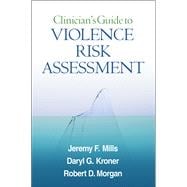
Clinician's Guide to Violence Risk Assessment
by Mills, Jeremy F.; Kroner, Daryl G.; Morgan, Robert D.Buy New
Buy Used
Rent Textbook
Rent Digital
How Marketplace Works:
- This item is offered by an independent seller and not shipped from our warehouse
- Item details like edition and cover design may differ from our description; see seller's comments before ordering.
- Sellers much confirm and ship within two business days; otherwise, the order will be cancelled and refunded.
- Marketplace purchases cannot be returned to eCampus.com. Contact the seller directly for inquiries; if no response within two days, contact customer service.
- Additional shipping costs apply to Marketplace purchases. Review shipping costs at checkout.
Summary
Author Biography
Table of Contents
| Violence Risk Assessment: An Introduction | p. 1 |
| The Clinician's Knowledge and Training | p. 3 |
| Why Conduct Violence Risk Assessments? | p. 5 |
| Therapeutic versus Violence Risk Assessments | p. 11 |
| Advancements in Risk Assessment | p. 15 |
| Ethics Essentials | p. 24 |
| Conclusion | p. 32 |
| Violence Risk Factors | p. 33 |
| Violent Reoffending in the Criminal Recidivist | p. 34 |
| Offenders with Mental Disorders | p. 36 |
| Sexual Violence | p. 44 |
| Spousal Violence | p. 50 |
| Psychopathic Traits | p. 55 |
| Conclusion | p. 64 |
| Risk Appraisal Instruments | p. 65 |
| Instruments Specifically Developed to Predict Nonsexual Violence | p. 69 |
| Instruments Developed to Predict General Reoffending That Also Predict Nonsexual Violence | p. 81 |
| Instruments Developed to Predict Sexual Violence | p. 87 |
| Instruments Developed to Predict Spousal Violence | p. 102 |
| Issues in Risk Assessment | p. 108 |
| Choosing a Risk Appraisal Instrument | p. 109 |
| Professional Override? | p. 118 |
| Assessing Change from Intervention/Treatment | p. 120 |
| The Perception and Communication of Risk Information | p. 124 |
| An Integrated-Actuarial Approach to the Assessment and Management of Risk for Violence | p. 134 |
| Anchoring the Assessment with Actuarial Estimates | p. 135 |
| Integrating Dynamic Factors for Intervention/Treatment and Risk Management Purposes | p. 136 |
| The Two-Tiered Violence Risk Estimates Scale: An Integrated-Actuarial Approach | p. 139 |
| Other Examples of Integrated-Actuarial Risk Assessment | p. 156 |
| Interventions to Reduce Risk | p. 157 |
| The Risk Assessment Process | p. 159 |
| Transparency | p. 159 |
| Information Gathering | p. 163 |
| Reporting the Findings | p. 167 |
| Telling the Story: An Outline for the Report | p. 172 |
| Assessment Context | p. 173 |
| Psychosocial Background | p. 177 |
| History of Violence and Criminal Behavior | p. 183 |
| Risk Assessment and Risk Management | p. 184 |
| Testifying in Legal Proceedings | p. 189 |
| Appendix. Sample Violence Risk Assessment | p. 193 |
| References | p. 207 |
| Index | p. 233 |
| Table of Contents provided by Ingram. All Rights Reserved. |
An electronic version of this book is available through VitalSource.
This book is viewable on PC, Mac, iPhone, iPad, iPod Touch, and most smartphones.
By purchasing, you will be able to view this book online, as well as download it, for the chosen number of days.
Digital License
You are licensing a digital product for a set duration. Durations are set forth in the product description, with "Lifetime" typically meaning five (5) years of online access and permanent download to a supported device. All licenses are non-transferable.
More details can be found here.
A downloadable version of this book is available through the eCampus Reader or compatible Adobe readers.
Applications are available on iOS, Android, PC, Mac, and Windows Mobile platforms.
Please view the compatibility matrix prior to purchase.
